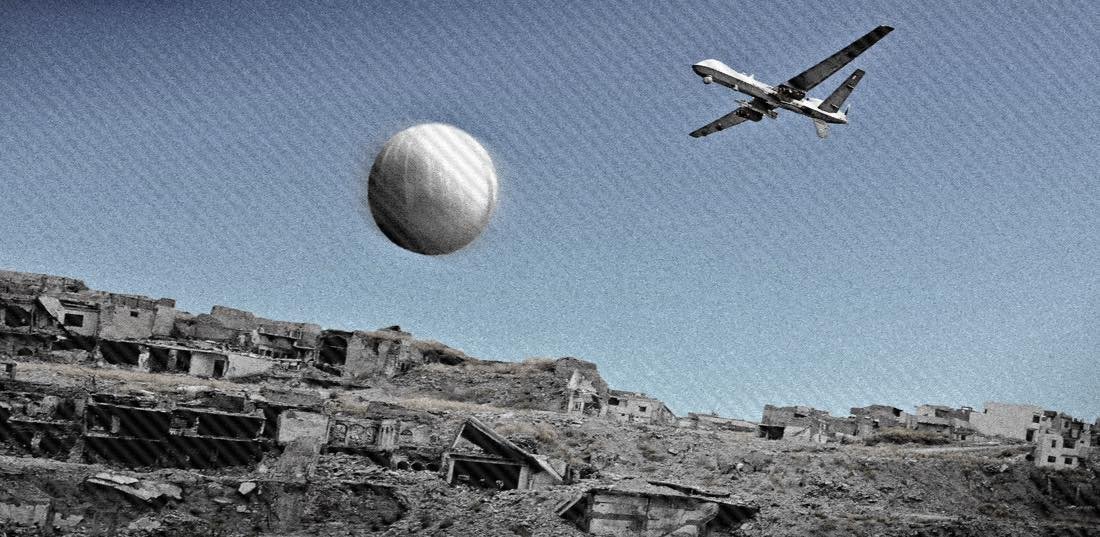During a congressional oversight hearing last week, the Director of the Pentagon’s All-domain Anomaly Resolution Office (AARO), Dr. Sean Kirkpatrick, discussed the Department of Defense’s ongoing efforts to investigate unidentified aerial phenomena (UAP).
The Senate Subcommittee on Emerging Threats and Capabilities hosted the hearing, including a closed-door classified briefing and an open public hearing led by U.S. Senator Kirsten Gillibrand (D-NY).
This marked the second time in nearly half a century that a public Congressional hearing has been held on a topic that has been historically referred to as “unidentified flying objects” or “UFOs.” A subject that is typically considered taboo by mainstream science and the Pentagon.
During his testimony, Kirkpatrick offered some of the most comprehensive comments on the Pentagon’s efforts, including details on UAP reporting trends, and introduced two new videos showing reported UAP events analyzed by AARO.
Last week, The Debrief published an overview of the hearing, “Senate Hearing on UAP Reveals New Videos and Common Features, But Says No Proof of E.T,” along with a deeper look at several key elements–and a few controversies–that followed Wednesday’s session.
As part of our continuing coverage, here we will highlight several key takeaways that could have been easily overlooked during these recent UAP hearings.
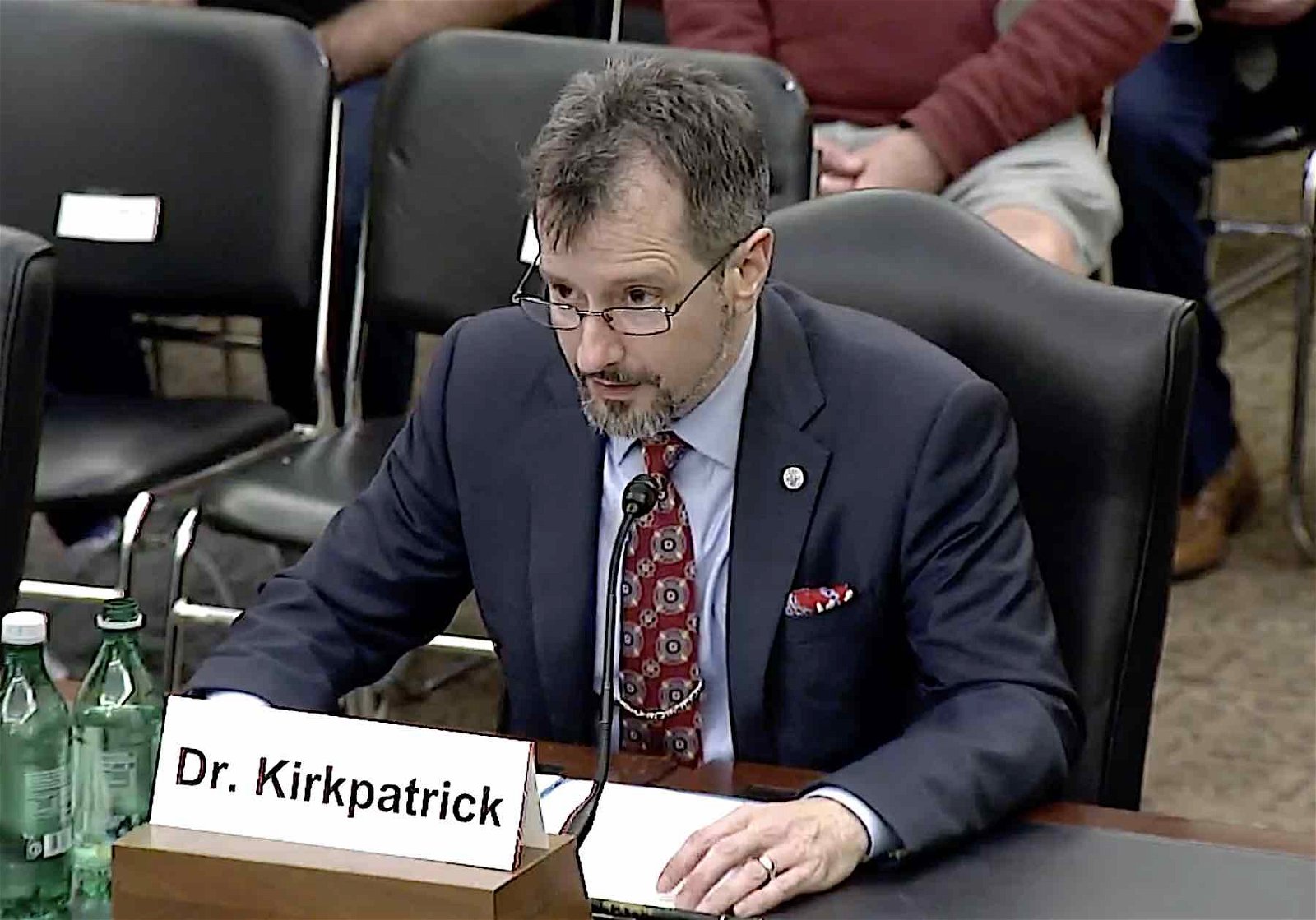

AARO Has No “Credible Evidence” That UAP Represents Extraterrestrial Activity
In his opening remarks, Dr. Kirkpatrick addressed the proverbial elephant in the room.
“I should also state clearly for the record that in our research, AARO has found no credible evidence thus far of extraterrestrial activity, off-world technology, or objects that defy the known laws of physics,” said Dr. Kirkpatrick.
“In the event sufficient scientific data were ever obtained that a UAP encountered can only be explained by extraterrestrial origin, we are committed to working with our interagency partners at NASA to appropriately inform the U.S. Government’s leadership of its findings.”
Predictably, these comments garnered much public attention and captured most media headlines.
Many proponents of the UAP topic were upset by Kirkpatrick’s “No E.T.” statements, with some taking to social media to declare that he must be part of an alleged ongoing government “cover-up” to hide the true alien origins of UFOs.
Critics of the topic reciprocated by seizing the comments as proof that all UAP encounters are merely misidentifications of mundane objects.
Many proponents and critics essentially grasp these statements like the tightly-spaced handholds used to ascend the pre-existing belief mountain.
The controversy over the “no credible evidence” for E.T. likely boils down to misunderstandings or differing interpretations of what constitutes “credible evidence.”
Typically, UAP sightings involve fleeting instances where someone sees something they can’t recognize that appears to exceed known technology. These events are often ambiguous and elusive, leaving investigators to rely on witness accounts or, in rare instances, limited physical evidence to piece together what might have happened.
Eye-witness accounts of UAP events can be valuable sources of information and should never be discounted. However, a host of empirical studies have demonstrated that witness testimony can be unreliable, manipulated, and biased.
Additionally, a person’s subjective assumptions, pre-existing knowledge, and beliefs influence how they view personal observations as evidence.
Throughout his nearly hour-long testimony, Kirkpatrick repeatedly expressed AARO’s steadfast commitment to taking an objective, measured, and scientific approach to investigating UAP.
“AARO’s work will take time if we are committed to do it right. It means adhering to the scientific method and the highest standards of research integrity. It means being methodical and scrupulous. It means withholding judgment in favor of evidence. It means following the data where it leads, wherever it leads. It means establishing scientific peer-reviewed theoretical underpinnings of observed data. And AARO is committed to all of those standards,” Kirkpatrick said during his opening remarks.
This means that during AARO’s analysis of UAP reports, witness testimony will be treated as one piece of evidence rather than as the sole or definitive source that forms an overall conclusion.
This does not mean that AARO has definitively determined that some UAP do not represent “extraterrestrial activity, off-world technology, or objects that defy the known laws of physics.”
To the contrary, given Kirkpatrick’s devotion to the scientific method, the mention that “no credible evidence thus far of extraterrestrial activity…” suggests some more “exotic” explanations for UAP is indeed a theory or hypothesis that’s on the table.
AARO is operating under Bayesian inference, with theories and conclusions still very open to change.
So the key takeaway from this opening statement is that AARO will not reach the conclusion that UAP represents a non-human intelligence unless it has definitive proof that can withstand the rigors of scientific scrutiny.
Given the profound implications that the discovery of extraterrestrial life would have, this is the exact approach most people should want.
Shots Fired At UFO Hobbyists and Skeptics
In his remarks, Kirkpatrick took what could be considered a shot across the bow at avocational UAP investigators, skeptics, critics, commentators, or vocal enthusiasts.
“For those few cases that have been leaked to the public previously and subsequently commented on by the U.S. Government, I encourage those who hold alternative theories or views to submit your research to credible peer-reviewed scientific journals,” said Kirkpatrick. “AARO is working to do the same. That is how science works, not by blog or social media.”
It’s worth noting these comments were part of Kirkpatrick’s prepared and published opening statement, so this was clearly a sentiment he wanted to make sure was expressed.
This was also a rare moment where both UFO enthusiasts and skeptics alike seemed to take issue with his statements equally.
“Dr. Fitzpatrick [sic] says UAP advances not made by blog or social media. How does he explain his butt being forced into a chair to testify? Did that happen by peer-review study?” longtime Canadian UFO researcher and author Grant Cameron wrote on Twitter.
Later, Cameron accused “Fitzgerald P.h.D. [sic]” of “playing a game” to “discredit sighting data.”
Popular self-styled debunker Mick West also took to Twitter to express his disagreement with Kirkpatrick’s description of how science works.
“Sean Kirkpatrick of @DoD_AARO said we should not analyze UFO videos via social media, and should submit to peer-reviewed publications, as that’s ‘how science works’ He’s wrong. Crowdsourcing over social media works, really well,” West wrote. West reinforced his point by sharing a link to a non-peer-reviewed article he had authored for Skeptical Inquirer on crowd-sourcing UFO investigations.
Most public commenters were cherry-picking what Kirkpatrick said by honing in on his statement regarding “how science works” as being “not by blog or social media.” Much of the pushback appears to have overlooked Kirkpatrick’s preceding statement, emphasizing that those with legitimate ideas on UAP should put in the work by providing verification of those theories through the peer-reviewed scientific process; he did not say that social media couldn’t be used in the research process.
Ironically, many of the criticisms online only appear to have solidified Kirkpatrick’s overall point on how definitive scientific conclusions are reached: the empirical process and submitting conclusions for open peer review is indeed the way science works.
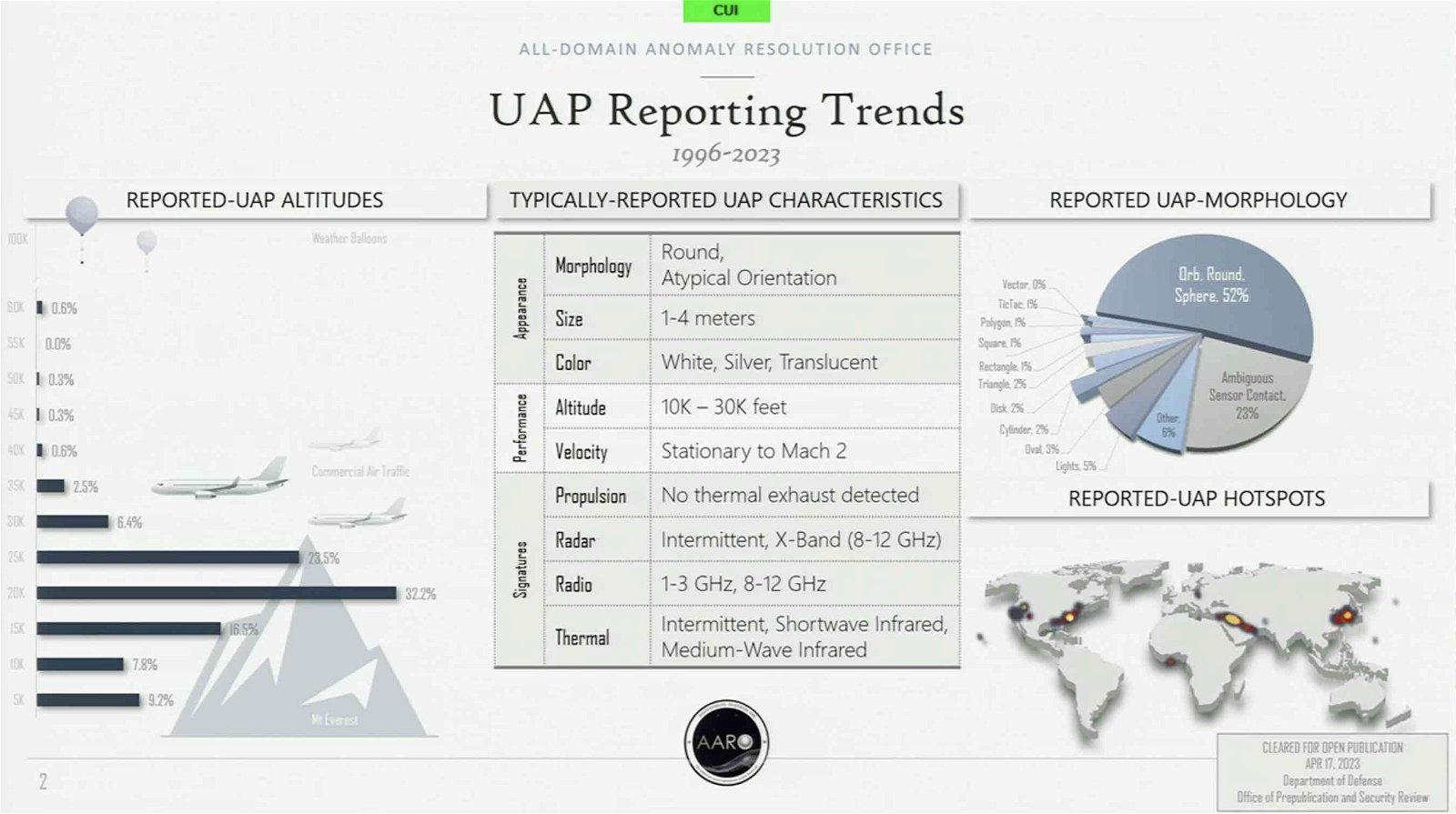

AARO Shares Trend Data That Was Formerly Withheld
In the first surprise of the hearing, Kirkpatrick presented a slide showing the “UAP Reporting Trends” from 1996-2023. To date, this was the most information the Pentagon has ever shared on some of the statistical patterns of UAP reports.
Most of the data provided wasn’t particularly surprising. For example, 89% of reported UAP altitudes were 10,000 to 35,000 feet. These are the altitudes that the vast majority of aircraft fly, so it makes sense to have more reports in the most traveled airspace regions.
A heat map showing the locations for UAP reports indicated that the majority have come from the Middle East, particularly near Iraq and Syria; in the Pacific near North Korea and China; and off the eastern and southwestern coasts of the United States.
To a lesser degree, some UAP reports also came from West Africa near Liberia, Poland, Afghanistan, Hawaii, and the middle of the Pacific Ocean.
As Kirkpatrick pointed out in his testimony, it’s no surprise that these areas produce the most UAP reports because they represent the areas where the U.S. military operates the most airborne collection platforms.
Another portion of the slide gave a statistical breakdown of the appearance of reported UAPs.
This was an unexpected and tantalizing detail because in a heavily redacted version of the 2021 classified preliminary assessment on UAP, obtained via FOIA by John Greenwald of The Black Vault, the “common” and “less common” shapes of UAP were withheld on the basis it could reveal “military plans, weapons systems, or operations.”
Notably, the portion marking on the preliminary assessment indicates that the shapes described in UAP reports were considered “unclassified.” Additionally, the UAP Classification Guide drafted by the now-defunct UAP Task Force in 2020 does not list UAP morphology as something inherently classified.
So it’s unclear why this information was initially withheld from release, but AARO has now finally made it public.
According to the statistical breakdown, 52% of UAP reports involve round, spherical, orb-like objects. Another 23% represented ambitious sensor contacts without visual confirmation. The remaining characteristics, ranging from 3%-1%, comprised varied shapes such as cylinders, disks, triangles, or “TicTac.”
Other typical characteristics included sizes between 3 feet to 13 feet and white, silver, or translucent. Most observed UAPs were noted as being stationary or traveling at speeds up to Mach 2 (1,534 mph).
Additionally, UAP did not typically display thermal exhaust indicating obvious signs of propulsion, were intermittently detectable on X-band radar, emitted radio frequencies between 1-3 GHZ to 8-12 GHZ, and produced intermittent shortwave and medium wave thermal infrared energy.
There is likely good reason to discount the alien hypothesis regarding UAP displaying radio emissions in the ultra-high frequency (UHF) ranges mentioned by AARO. These frequency bands are commonly used in many terrestrial applications, including radar, wireless and satellite communication, and airborne surveillance.
In addition to providing new information, Kirkpatrick successfully added a new mystery to the mix by sharing that AARO had been analyzing UAP cases going back to 1996.
In the 2021 Preliminary report and the 2022 annual report on UAP (just published three months ago), the DoD indicated that the cutoff range for reports went back to 2004. AARO has now pushed that timeline back eight years.
AARO analyzing reports going back to 1996 was first mentioned by Kirkpatrick during an early December 2022 media roundtable with Under Secretary of Defense for Intelligence and Security Ronald Moultrie.
When asked to clarify comments that AARO had received “several hundred” sighting reports and whether that represented the total number of reports being analyzed, Kirkpatrick replied, “It is — I would characterize it as on the total reporting since I believe our cut-off; going backwards was 1996 through now.”
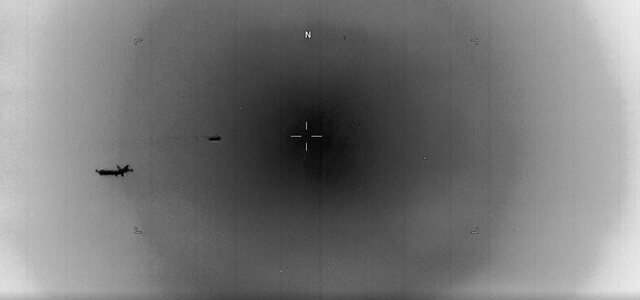

The DoD Is Willing To Share UAP Info, Provided It Leaks First
Kirkpatrick shared two new, previously unpublished UAP videos in another welcome surprise.
The first was a video of an “apparent spherical object” captured by electro-optical sensors from a U.S. Air Force MQ-9 Reaper drone over an undisclosed area in the Middle East.
According to Kirkpatrick, the 24-second clip of the flying sphere represented some of the 52% of UAP reports analyzed that remained unidentified.
Kirkpatrick stopped short of calling the unknown object “anomalous,” pointing out that limited data made it difficult for AARO to reach a firm conclusion.
“This [the video] is essentially all of the data we have associated with this event from some years ago,” said Kirkpatrick. “It is going to be virtually impossible to fully identify that just based off of that video.”
The video, made publicly available on the Senate Armed Services Committee’s website, includes a title page indicating the event occurred on July 12, 2022. Assumingly, Kirkpatrick misspoke when he described it as being “from some years ago,” as it appears the images were captured roughly within the last nine months.
One conventional airborne object the flying sphere might resemble would be a balloon. Unfortunately, Kirkpatrick did not clarify if this had been labeled as one of the unidentified “balloon-like” objects noted in AARO’s annual report or if other factors would indicate the object had some form of propulsion.
A second video taken over South Asia on January 23, 2023, appeared to show a disk-like object zooming past an MQ-9 drone as it was filmed by another Reaper drone flying nearby in formation.
“Unlike the previous one, this one actually shows some really interesting things that everyone thought was truly anomalous,” said Kirkpatrick.
“First of all, it’s a high-speed object that’s flying in the field of regard of two M.Q. 9’s. Second, [it] appears to have this trail behind it. All right, which, at first blush, you would think that looks like a propulsion trail.”
Kirkpatrick explained that what initially appeared to be a propulsion trail was actually a sensor artifact or “shadow image” of the object. Crushing any further hopes that this was a genuinely anomalous UAP, analysis by AARO revealed the disk-like object was just the heat signature from the engines of a nearby commuter aircraft, the outline of which Kirkpatrick showed to be visible with the aid of additional enhancements to the original footage.
Perhaps the most intriguing aspect of the newly released AARO footage is that both videos displayed characteristics of other recently leaked DoD imagery of purported UAP.
In late January 2023, filmmaker Jeremy Corbell and journalist George Knapp published several still images reportedly taken by a U.S. MC-12 intelligence, surveillance, and reconnaissance (ISR) aircraft over northern Iraq, showing what appears to be a flying spherical object.
According to information provided by Knapp and Corbell, the object was initially captured on April 16, 2016. The images were leaked after being included in a classified briefing document prepared by the DoD’s UAP Task Force in 2020.
Of particular note, the orb-like UAP from Corbell and Knapp’s leaked images, which was reportedly observed over Mosul, northern Iraq, is nearly identical to the spherical object shown in the video shared last week by Kirkpatrick.
In early March, Corbell and Knapp again published newly leaked images of UAP, in this instance provided by someone within the U.S. Air Force, who expressed concerns over how they felt officials were withholding UAP information from both the public and AARO.
The six images, which have since been dubbed the “Baghdad Phantom,” appeared to show a flying cylindrical object that was reportedly also captured by a U.S. Air Force Reaper drone on May 14, 2022.
While it is impossible to discern what the object in the footage is, the photos seem to display a propulsion trail similar to the one Kirkpatrick explained to be a “sensor artifact” in the South Asia video shared during last week’s hearing.
In effect, the two new videos made public during the hearing and discussed by Kirkpatrick could be interpreted as being responses to the prior leaks by Knapp and Corbell, a possibility for which there already appears to be some precedent.
At last year’s hearing on UAP hosted by the House Intelligence Counterterrorism, Counterintelligence, and Counterproliferation Subcommittee, Deputy Director of Naval Intelligence Scott Bray also shared a pair of what were characterized as new UAP videos.
Similar to what Kirkpatrick shared last week, Bray’s videos included one depicting an object which remains characterized as unidentified and another presented as an example of how some previously leaked UAP footage had been resolved. The first was of a “spherical object” captured by a Navy pilot from the cockpit of a F/A-18 fighter jet in 2021.
“What you see here is an aircraft that is operating in a U.S. Navy training range that has observed spherical objects in that area. And as they fly by it, they take a video; you see it looks reflective,” Bray said.
“I do not have an explanation for what this specific object is,” Bray added.
The video of the spherical object shared by Bray in 2022 closely matched still images of an amorphous flying object captured from the cockpit of a F/A-18, which also appeared in a UAP Task Force report. One of these images was leaked to The Debrief and first published in December 2020. Two additional photographs from the same photo series were leaked and later published by Corbell and Knapp in April 2021.
The other video shared by Bray in last year’s Congressional hearing was recorded using night vision, revealing what appears to be a perfectly triangular flying object. According to Bray, when the light source resolves itself through the night vision goggles onto the SLR camera, it can cause an object to appear triangular. What is really depicted in the video, Bray explained, is a “drone [or] some type of unmanned aerial system.”
Here again, the UAP video Bray discussed during the Congressional hearing was seemingly identical to a leaked video published by Jeremy Corbell in 2021, which depicted an object resembling a “flying pyramid.” According to Corbell, the video Bray offered as a resolved instance of UAP was taken during a wave of UAP incidents in July 2019 with the U.S. Navy’s Carrier Strike Group 9 off the coast of San Diego.
The Pentagon later confirmed to The Debrief that the video leaked by Corbell was authentic, and involved an incident being investigated by the DoD’s UAP Task Force.
The Pentagon normally takes the unauthorized leak of privileged DoD information extremely seriously. However, when it comes to leaks involving UAP, curiously, the DoD seems to become more forthcoming and willing to share.
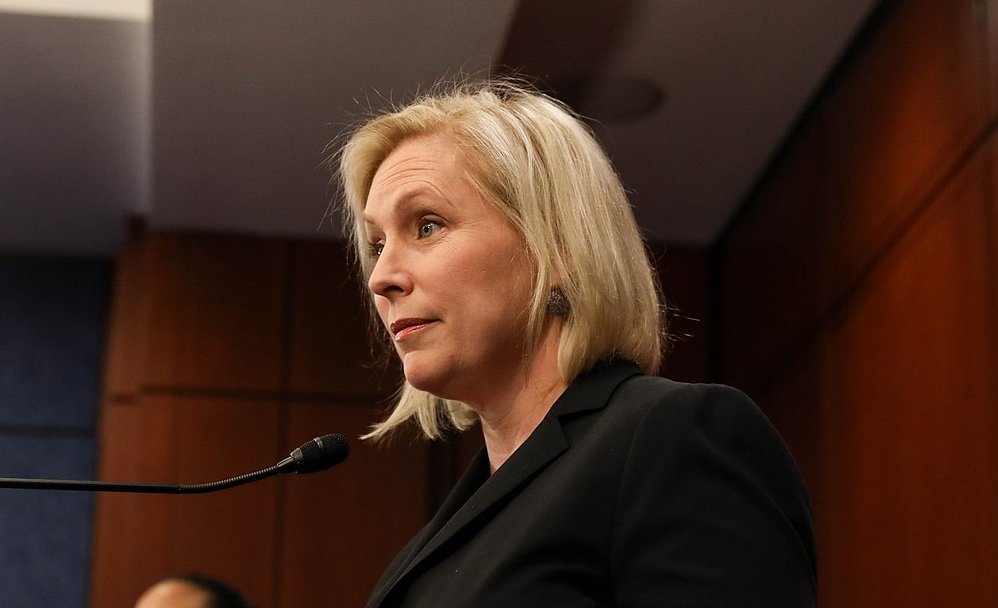

What Happened To The Complaints of AARO Being Underfunded?
In February, sixteen U.S. Senators sent a letter to Deputy Secretary of Defense Kathleen Hicks and Principal Deputy Director of National Intelligence Stacey Dixon, expressing dissatisfaction with AARO’s funding.
“While we recognize there was an Administration request for funds in Fiscal Year 2023 (FY23) to fund basic operating expenses for AARO, it is facing a funding shortfall that will impede its ability to fulfill its mission,” the letter read.
“We believe it is imperative for the Department of Defense to reprogram funds to cover this serious funding gap, and it is for these reasons we ask that the Department of Defense reprogram funds to prevent disruption to AARO’s work,” the letter added.
During last week’s hearing, Senator Joni Ernst (R-IA) asked Kirkpatrick to explain what made AARO unique to other existing DoD offices. There was a hint of political theater in Sen. Ernst’s question, perhaps suggesting that the DoD may have tried to dispel lawmakers’ concerns about funding by saying that AARO was replicating work already being done by the DoD.
Aside from this brief exchange, AARO’s budget or apparent need for more funding did not come up. Any budget concerns were likely discussed during the closed-door hearing Senators had with Kirkpatrick just before the public hearing. Typically, closed-door Congressional hearings are held after a public hearing. However, in this recent secession, Sen. Gillibrand scheduled the classified portion first.
One possible reason for holding the closed session first may have been to go ahead and get the budget issues out of the way, particularly since it was reported that more Senators were in attendance for the earlier closed-door session.
AARO Is Using The Standard Intelligence Community Model Of Analysis
In describing AARO’s analysis process, Kirkpatrick described the standard five-step intelligence cycle, the gold-standard analysis model used by the U.S. Intelligence Community.
Step one of the process involves planning and direction for what specific collection requirements are needed. This is followed by the collection process, which gathers necessary raw information needed to produce a finished intelligence product.
Stage three involves converting collected information to a form usable by analysts. With this, Kirkpatrick explained that AARO performs a preliminary scrub of UAP reports to determine if an event displays characteristics that range from something mundane, such as a balloon or bird, to objects showing “some anomalous phenomenology that is of interest.”
“So there’s sort of a hierarchy of just binning the priorities because we can’t do all of them at once,” said Kirkpatrick.
In the fourth step, the analysis and production stage of the intelligence cycle, Kirkpatrick said AARO takes a competitive approach toward examining UAP reports, using two separate teams of subject matter experts in its investigations. One team comprises science and technology experts (e.g., physicists, engineers, etc.), while the other includes analysts from the intelligence community.
“Those two groups give us their answers. We then adjudicate if they agree, then I am more likely to close that case if they agree on what it is,” Kirkpatrick said. “If they disagree, we will have an adjudication. We’ll bring them together, [and] we’ll take a look at the differences. Why do you say one thing and you say another? We will then come to a case recommendation.”
This type of competitive analysis is a common system used by the Intelligence Community. In theory, it is designed to draw upon a diverse knowledge base while limiting biases, as each group separately engages data through the lens of their specific expertise. An additional step in the AARO’s analysis process includes a peer review by a senior technical advisory group of “senior technical folks and intel analysts, and operators” who are retired from the Intelligence Community. The fifth and final stage involves the dissemination of conclusions arrived at during the intelligence cycle.
Kirkpatrick explained that currently, this final stage involves disseminating case reports on a classified web portal, “where we can then collaborate with the rest of the community so they can see what’s going on.”
Ok, But What Happens Next?
The conclusion of one intelligence cycle logically feeds into the start of a new analysis cycle.
Kirkpatrick hinted at what the next intelligence cycle of UAP might resemble by mentioning that AARO was “looking at applying a lot of things, new tools, analytic tools, like natural language processing.”
“So I can go across all of those reports and look for commonalities, [such as] how many of them are being described as round spherical objects that are maneuvering? How many of them are not maneuvering? How many of them seem to have plume to it?” Kirkpatrick said last week.
“That’s also going to be very valuable to give us more of a global picture and a trends analysis of what we are seeing and help us get to the determination.”
This means that AARO will likely carefully analyze its unknown cases or, as Kirkpatrick put it, the “very small percentage of UAP reports display signatures that could reasonably be described as anomalous.”
The next step will likely involve putting together a collection plan, allowing AARO to gather its own UAP data instead of relying on reports given to them.
A specific UAP collection mission could involve tens of millions of dollars, which is why it would be essential for AARO to justify the need through its initial intelligence cycles.
As far as what’s publicly known, the U.S. Government has never engaged in a collection mission specifically targeting UAP. Should things progress this far, it would be unprecedented.


AARO May Have Limited Access To The Intelligence Community
One of the most significant but overlooked portions of the hearing came when Senator Jacky Rosen (D-NV) asked Kirkpatrick about AARO’s ability to access data that it may need to investigate UAP.
“Do you have the authorities you need to extend your collection posture between agencies or branches of the military?” asked Sen. Rosen. “Do you need any authorities that you don’t have to get the data you need?”
In his response, Kirkpatrick revealed AARO was currently operating under Title 10 authority and that “there are some authorities that we need.”
This exchange ultimately boils down to the difference between Title 10 and Title 50 authority.
Demystifying the Title 10 vs. Title 50 debate has previously been the stuff of 60-page Harvard legal reviews. However, in a nutshell, Title 10 of the U.S. Code provides authority for the U.S. armed forces, including clandestine military activities. Most activities conducted by the Intelligence Community, including covert action, foreign espionage, and missions most suited for combating unconventional external threats, operate under Title 50 authority.
Theoretically, Title 10 and Title 50 represent mutually supporting, not mutually exclusive, authorities. In practice, agencies and components often zealously guard their respective span of control, typically refusing to share information or work with others outside their jurisdiction.
This is particularly true with the Intelligence Community, which often views Title 10 components as inferior to those with Title 50 authority.
So what does this all mean regarding AARO and the Pentagon’s UAP investigations?
This means that operating solely under Title 10 authority, AARO has limited ability to force the Intelligence Community to assist in UAP investigations, including sharing data or reports and tasking collection assets. This could include highly-relevant Title 50 missions conducted by agencies like the CIA, National Reconnaissance Office (NRO), National Geospatial-Intelligence Agency (NGA), or the National Security Agency (NSA).
Of course, this doesn’t mean the Intelligence Community is blowing AARO off. It just means it can more easily say “no” whenever agencies decide they don’t want to play along.
Kirkpatrick attempted to downplay AARO’s lack of Title 50 authority, saying, “We have, you know, good relationships across the other agencies.” However, he admitted that “having additional authorities for collection, tasking, counter-intelligence, those are all things that would be helpful, yes.”
“Dr. Kirkpatrick, will you help us write that language so we can put it in the defense bill this year so that we know what authorities you need?” Sen. Gillibrand immediately followed up. Unfortunately, we couldn’t see Kirkpatrick’s facial expression in response to this, although it was probably a forced half-smile of reluctance and reservation.
The brief exchange over AARO’s authority (or lack thereof) seemed to incidentally spill into the public hearing. Often, these types of conversations would occur during a closed-door session. Nevertheless, they offered a peek into the Byzantine nature of the U.S. Government and the precarious balance officials often have to navigate between senior leadership’s and lawmakers’ conflicting interests.
Hints That AARO Maybe Facing Some “Administrative Terrorism”
At several points during Kirkpatrick’s testimony hinted that AARO has faced some administrative obstacles.
Toward the end of the hearing, Sen. Gillibrand asked about the status of a Congressionally mandated program allowing UAP witnesses or government officials with UAP information to come forward to tell their stories.
In response, Kirkpatrick revealed that AARO had “submitted the first version of that before Christmas.”
“And do you have an estimate from them when they will respond? Or when you’ll have feedback on that?” Sen. Gillibrand followed up.
“No, I don’t,” replied Kirkpatrick.
Kirkpatrick also revealed that AARO had submitted “a number of public engagement recommendations” to the office of the Under Secretary of Defense for Intelligence and Security (OUSD(I&S)). According to him, these recommendations were still “waiting for approval.”
In another exchange, Sen. Gillibrand noted that AARO is administratively located within OUSD(I&S). However, Kirkpatrick is supposed to report directly to the Deputy Secretary of Defense.
“Are you taking direction directly from the Deputy Secretary? Are you able to meet and brief the Deputy Secretary?” asked Sen. Gillibrand. “Is the office of USD I&S working with you to have the right framework?”
Kirkpatrick stumbled to find a politically correct response to what was likely a very uncomfortable question.
“So USD(I&S)… I currently report to USD(I&S) until they come up with a plan for how they’re going to implement legislation,” Kirkpatrick replied. “DoD and DNI are working through that now. I’d have to refer you back to USD(I&S) on what their plan is.”
Gillibrand asked Kirkpatrick if this was an issue she needed to clarify further in next year’s National Defense Authorization Act (NDAA).
Still trying to navigate the dangerous waters of not upsetting current bosses, Kirkpatrick replied, “I think they’re planning on coming back to you with an answer on [what] that plan is, and I think at that time that will inform what you want to do.”
There are good reasons for Sen. Gillibrand’s concerns about AARO currently falling under the USD(I&S). Current and former Pentagon officials who worked on the DoD’s previous UAP investigative efforts have accused senior leadership at OUSD(I&S) of intentionally hobbling efforts to investigate UAP.
In an exclusive last year, The Debrief revealed that the Director of Defense Intelligence for OUSD(I&S), Garry Reid, had been investigated for numerous accusations of misconduct.
In 2021, the former Director of National Programs Special Management Staff at OUSD(I&S), Luis Elizondo, filed a complaint to the DoD Inspector General’s Office, accusing Reid of retaliation against him and intentional obfuscation of the UAP topic.
In April last year, Reid was abruptly removed from his position and reassigned as a non-supervisory advisor for the Defense Intelligence Agency (DIA).
Speaking on a condition of anonymity as they were not allowed to talk on the record, two senior defense officials told The Debrief there had also been issues between OUSD(I&S) and the former UAP Task Force.
According to these officials, there had been rifts between the former UAP Task Force director John Stratton and the Director for Defense Intelligence, Collection, and Special Programs at OUSD(I&S), Neil Tipton, and his senior advisor, Matt Cummings.
Reportedly, the disagreements centered on Tipton and Cummings’ disdain for OUSD(I&S) being involved in the investigation of UAP and Stratton’s ability to brief senior Pentagon officials without their prior approval.
Stratton has since retired from government and now works in the private sector. Both Tipton and Cummings are still at OUSD(I&S).
Whether any administrative obstacles AARO has faced with OUSD(I&S) are intentional is unknown. However, Sen. Gillibrand’s line of questioning, paired with Kirkpatrick’s noticeably uncomfortable responses, hint that there may be more issues behind the scenes than many realize.
Whenever bottlenecking is intentionally undertaken by indifferent or overbearing management, the colloquial term for this that is often used by those working in the Pentagon is “administrative terrorism.”
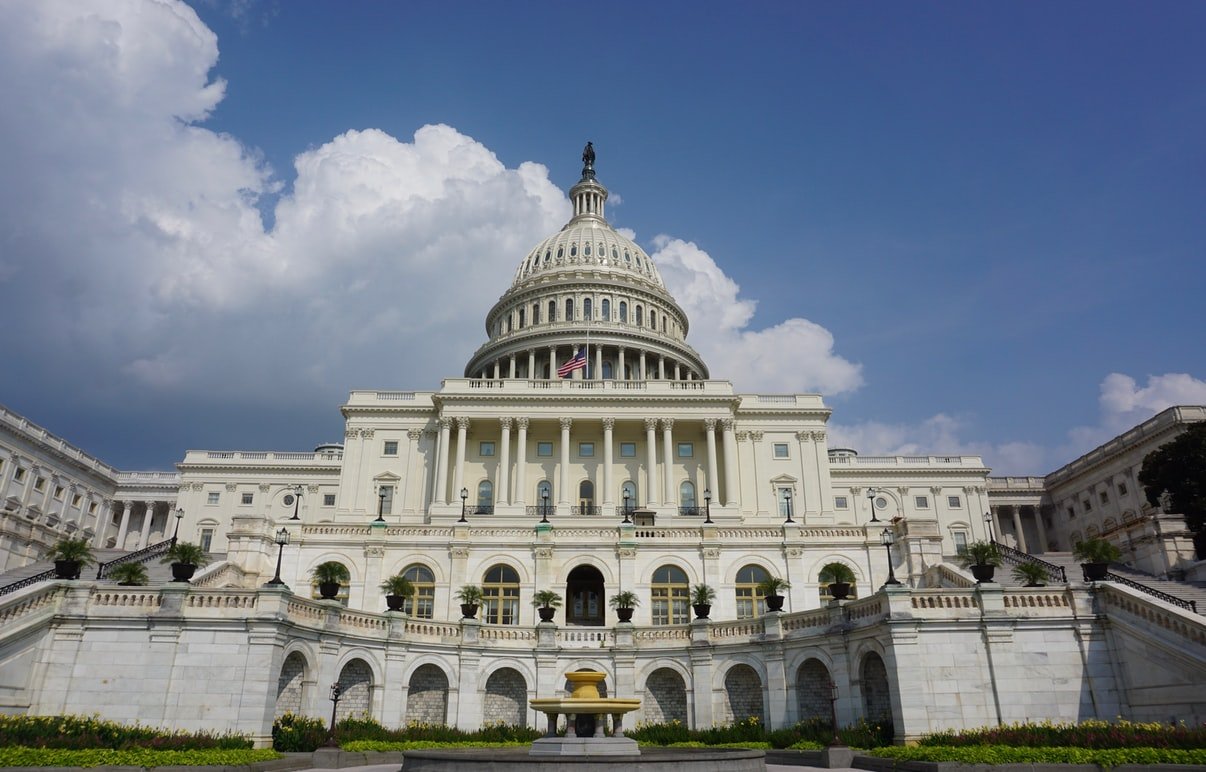

The Undiscussed Dark Horse of Government-Led UAP Investigations
While the issue did not arise during last week’s hearing, another U.S. government entity is apparently currently conducting its own UAP inquiry. On February 13, National Security Council spokesperson John Kirby announced that President Joe Biden had launched a “whole-of-government” investigation into unidentified aerial objects entirely separate from AARO’s efforts, focusing on objects the likes of which were shot down over the U.S. in a series of incidents in February.
“The President, through his National Security Advisor, has today directed an interagency team to study the broader policy implications for detection, analysis, and disposition of unidentified aerial objects that pose either safety or security risks,” Kirby said. “Every element of the government will redouble their efforts to understand and mitigate these events.” National Security Advisor Jake Sullivan has been tasked with leading the White House’s UAP inquiry.
Within the bureaucratic labyrinth of the U.S. government, the President’s National Security Advisor is one of the most influential and powerful positions one can hold. Those filling the position will serve as the principal advisor to the President on all national security issues, and will typically chair all meetings of the National Security Council (NSC) not attended by the President.
While they do not possess statutory authority like Cabinet members, such as the Secretary of Defense or Director of National Intelligence, the National Security Advisor serves under the President’s executive authority granted by Article II of the U.S. Constitution. This means any concerns over how much authority or access AARO has do not apply to the NSC-led effort to explore UAP.
Acting on behalf of the White House, the NSC has the authority to access any and all classified materials from any branch of government, including those outside the DoD or ODNI, such as the Department of Justice, Department of Energy, NASA, or the National Oceanic and Atmospheric (NOAA).
Contrary to popular belief, no classification level exceeds the White House’s reach, and the authority to classify anything comes directly from the President’s executive power. So even Special Access Programs (SAPs), including unacknowledged or waived-acknowledged SAPs, are accessible to the NSC pursuit of UAP info.
Whether or not Biden’s whole-of-government review will reveal anything new about UAP is up for debate. In the past, former President Bill Clinton previously revealed that he and his Chief of Staff, John Podesta, made every effort to get to the bottom of what the U.S. Government knows about UFOs. This even included sending his National Security Advisor, Sandy Berger, to Area-51 to see if any crashed UFOs or alien bodies were secretly tucked away at the high security facility. For all their searching, Clinton says that no one from his administration ever found any alien bodies or evidence of extraterrestrials.
Although Clinton has never denied that he was unable to find out more about UFOs during his two terms in the White House, some influential people around Clinton at the time later unambiguously hinted that there is indeed more UFO info out there.
After leaving his position as senior advisor to President Barack Obama, Clinton’s former Chief of Staff, John Podesta, lamented that one of the biggest failures during his most recent stint in the White House was not securing the release of the government’s UFO files.
“Finally, my biggest failure of 2014: Once again not securing the #disclosure of the UFO files. #thetruthisstilloutthere,” Podesta posted on Twitter.
While campaigning for the Presidency in 2016, Hillary Clinton also told late-night talk show host Jimmy Kimmell that, barring any threats to national security, she would open up the government files on UFOs if elected. Clinton lost the White House to President Donald Trump, so we’ll never know whether or not her comments were simply made in jest.
Ironically, while speaking with Kimmell in March of 2016, Clinton was already clued in on the newly accepted parlance for sightings historically referred to as unidentified flying objects, or UFOs.
“You know, there’s a new name,” Clinton told Kimmell. “It’s unexplained aerial phenomenon. U.A.P. That’s the latest nomenclature.”
The term wasn’t necessarily new, and the U.K.’s Ministry of Defense had been referring to UFO sightings as UAP since the 1990s.
Roughly a year after Clinton mentioned it on Kimmel’s program, the DoD christened UAP as the official term for “airborne objects not immediately identifiable.”
It remains to be seen whether the DoD’s current efforts with AARO, or President Biden’s new UAP inquiry within the NSC will finally succeed at putting to bed the mystery surrounding unidentified objects in America’s skies.
Tim McMillan is a retired law enforcement executive, investigative reporter and co-founder of The Debrief. His writing covers defense, national security, and the Intelligence Community. You can follow Tim on Twitter: @LtTimMcMillan. Tim can be reached by email: tim@thedebrief.org or through encrypted email: LtTimMcMillan@protonmail.com
